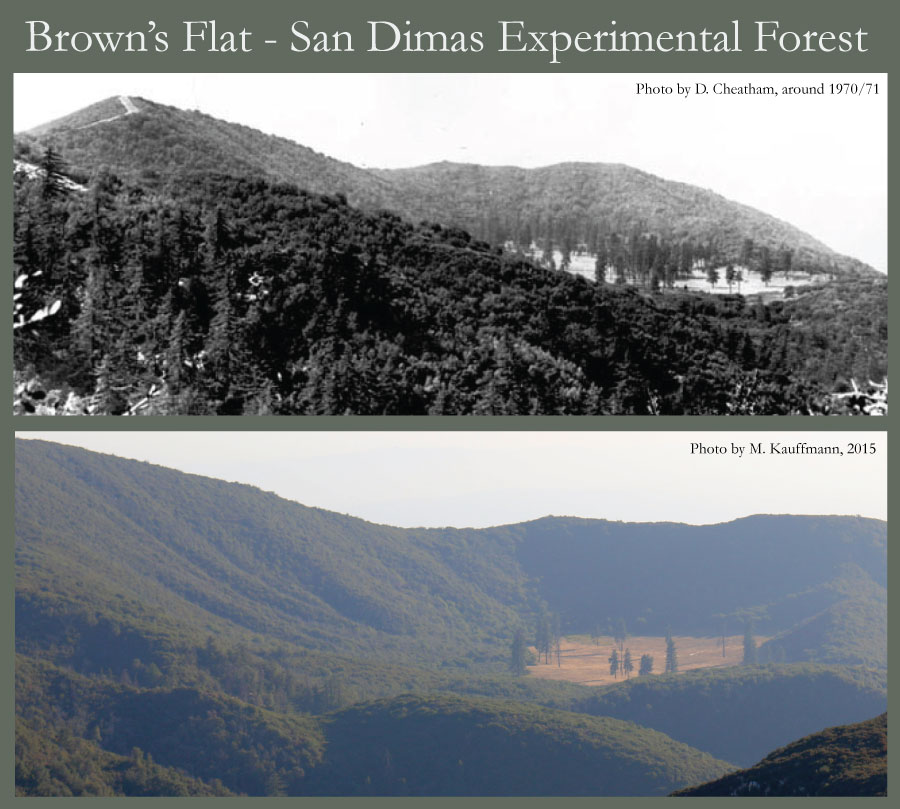Bigcone Douglas-Fir (Pseudotsuga macrocarpa) in the San Gabriel Mountain National Monument — Part one
I have always wanted to visit the San Dimas Experimental Forest and as part of a mapping and monitoring project for bigcone Douglas-fir, I finally had the opportunity. The “forest” descriptor in the area’s title is a bit misleading, as the majority of the vegetation is chaparral–but there are trees and it was our mission to find them (or at least what remains). Six major fires have been documented here since 1914, with the most recent occurring about 10 years ago. These fire events, along with climate change, are rapidly reshaping the remaining stands of trees. What follows is a photographic journey into the front range foothills of the eastern San Gabriel Mountains.





Fern Canyon Research Natural Area – San Dimas Experimental Forest
From the RNA Report:
Low-Elevation Ponderosa Pine: Brown’s Flat, a shallow 80-acre (32-ha) bowl created by an ancient land slump, contains the lowest elevation stand of Pinus ponderosa in S. California (about 3900 ft, 1189 m). This relictual stand of 81 individuals is well-isolated from other ponderosa pine stands in the San Gabriel Mountains and strongly affected by air pollution. There is almost no recent reproduction.
We counted 27 individuals in September 2015.

From the RNA Report:
Bigcone Douglas-fir: The stands of bigcone Douglas-fir at Fern Canyon have burned recently (1975). Poor reproduction suggests that the fire had a negative effect on seedling and sapling establishment. However, many of the larger trees, although scarred, survived the fire. The local stands should provide interesting comparisons with other stands in Millard Canyon and Falls Canyon RNAs, which have not been affected by fire for many years.


Hello, I am a enviornmental science major studying at Chaffey College. Is there any way I can help with this problem?
Aaron- Great question, but difficult to answer. First, I’m assuming your are asking about the Brown’s Flat ponderosa pines…I think the best approach is to get in touch with the Angeles National Forest botanist and encourage initiating a project that maps the remaining trees. We will then, at least, have a baseline moving forward.
Thank you. I just moved to San Dimas and just learned of the Expoerimental Forest. Currently I attempting to grow Live Oak from accorns i gathered from Walnut Creek. I hope we can do the same with Ponderosa and the Bigcone if they ever produce again. Is air polition and intense fires the main reason for their sterilization?
I am exploring the planting of the Big Cone Spruce/Douglas Fir macrocarpa on our property east of Clovis CA at about 3800Ft elevation. As you might know the Ponderosa Pine has been almost wiped out by the bark beetle. My friend that is the forester for Southern Ca. Edison has suggested using this tree for replanting, mixing it with pine and cedar. From the description of soil and other requirements the macrocarpa might grow perfectly, sheltered among the live and black oaks. The question is where is a source for purchase. I thank you in advance for your ideas and assistance.
Stanley- Sounds like a great idea! This is the time of year when the cones should be almost ready to drop seeds, so you might just want to go harvest some and put them in the ground before the rains come. Another idea is to use this resource: http://www.cnps.org/cnps/grownative/where_to_buy.php
Good luck!
Judging from the photos, I have a hard time believing the loss of trees is caused by air pollution. Air pollution has consistently improved in the LA basin for 60+ years. Has anyone looked closer at the bark beetle scenario? Any further info on this study?
Adam- That report was from 1971 and, to my knowledge, no one has looked at Brown’s Flat since because the area is more or less surrounded by impenetrable chaparral. My guess is you are right, decline is not as much attributable to pollution – instead aridification is the most likely culprit.
I find this fascinating.I am an Arborist specializing in bark beetles and can bushwack my way to Browns flat. Let me know how we can get an expedition going to research this unique microclimate and figure out what is causing the decline in this stand of Ponderosas.
Glad to see a few pines still remain at Browns Flat. I hiked in there twice in the early 1960s. I think that decreases in precipitation and the secondary effects it causes are the main factors in the decline. BTW: It’s a hell of a hike in there from Baldy Village or up from Evey Canyon.
Steve – thanks for the comment. I fear this stand of trees is not going to be around much longer based on what is happening to the bigcone Douglas-fir nearby. I was pushing the forest service to set up some long term monitoring here in 2015 but that has not happened…
I’m hoping that this year is El Nino will give enough rain to sprout some of those pine cones on the ground in Browns flat. I plan on checking it out sometime in late spring I will keep you updated